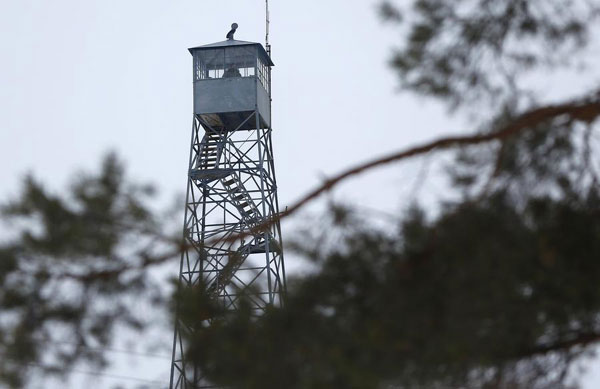Oregon standoff over federal control of US Western lands continues
Updated: 2016-01-04 14:48
(Xinhua)
|
|||||||||||
 |
|
A watch tower is manned at the Malheur National Wildlife Refuge near Burns, Oregon, January 3, 2016. [Photo/Agencies] |
SAN FRANCISCO - A group of militiamen, who were in dispute with the US government over the use of federal lands, on Sunday continued to stay at a federal building they took a day ago in the northwestern state of Oregon.
The incident at the Malheur National Wildlife Refuge took place after a demonstration on Saturday in Burns, a small town about 450 km southeast of Portland, Oregon, in support of two local ranchers facing additional prison time for arson.
WHO PROTEST
Ammon Bundy, from Nevada, said he and two of his brothers were "planning on staying here for years" and "this is not a decision we've made at the last minute."
In an early Sunday morning telephone interview with Cable News Network, the 40-year-old son of Nevada rancher Cliven Bundy, seemed to be hesitant specifying his demands against the federal government.
He said some members of the group in the building was armed. In a message posted on Facebook, he called on "all patriots" across the United States to join him.
Some militiamen told OregonLive earlier that there were about 150 of them, but a couple who delivered food to the site estimated that there were just 15.
Cliven Bundy staged in April last year an armed standoff with federal agents in Bunkerville, Nevada, over grazing rights on federal land. It lasted several weeks, drawing national attention and the participation of militiamen with assault rifles from around the country.
FOR WHOM THEY PROTEST
Bundy and other militia members, who gathered in Burns last month, were upset over the looming prison sentences for local ranchers Dwight and Steven Hammond.
Dwight Hammond Jr., 73, and his son Steven Hammond, 46, were convicted in 2012 for setting fire in 2001 and 2006 to public land adjacent to their ranch. The 2001 blaze burned 139 acres of public land, according to court documents; the 2006 fire -- for which only Steven was convicted -- burned another acre of public land.
The father and son served prison terms of three months and one year respectively.
However, under the Antiterrorism and Effective Death Penalty Act of 1996, which was passed in the wake of the Oklahoma City bombing, the mandatory minimum punishment for arson committed against federal property was upped to five years in federal prison.
A federal judge in October ruled the Hammonds to return to prison for about another four years each.
"Even a fire in a remote area has the potential to spread to more populated areas, threaten local property and residents, or endanger the firefighters called to battle the blaze," District Judge Stephen J. Murphy wrote in the appellate court's opinion. "Given the seriousness of arson, a five-year sentence is not grossly disproportionate to the offense."
Dwight Hammond told supporters at his home Saturday that he and his son would surrender to authorities Monday.
DISPUTE OVER LAND
W. Alan Schroeder, the Hammonds' lawyer, wrote to Sheriff David Ward of Harney County, where the wildlife refuge is located, to distance his clients from the militiamen, saying "neither Ammon Bundy nor anyone within his group/organization speak for the Hammond Family."
Even Cliven Bundy, Ammon's father, expressed his hesitation over the protests. "I don't quite understand how much they're going to accomplish," he told Oregon Public Broadcasting. "I think of this this way: what business does the Bundy family have in Harney County, Oregon?"
In fact, the seeds of protest of the militiamen were sown by a decade-long dispute between some Westerners and the federal government over the use of public lands. The issue traces back to the 1970s and the Sagebrush Rebellion, a movement during the 1970s and 1980s that sought more local control over federal land in the American West.
According to the Congressional Research Service, in Nevada the U.S. owned more than 81 percent of the state's land in 2010. In Oregon, that number hovered right around half -- 53 percent of the state's land, or more than 30 million acres.
Some ranchers have strongly objected to the government's management of federal lands, especially over issues of water or environmental conservation, and to the terms of their leases. But critics of the push for more local control have said the federal government should administer the public lands for the widest possible uses.
WHAT'S NEXT
Ammon Bundy, the apparent leader of the protest, who spoke by phone to CNN on Sunday, called on the government to restore the "people's constitutional rights."
The occupiers said their mission was to put the federal lands under local control, though it is unclear by what means.
The refugee is a popular destination for spring birdwatchers, and the headquarters include a visitor's center, museum and housing.
Oregon Senador Ron Wyden said federal and local officers were paying close attention.
Ward, the sheriff of Harney County, said the group of armed protesters came to town under false pretenses.
"These men came to Harney County claiming to be part of militia groups supporting local ranchers, when in reality these men had alternative motives to attempt to overthrow the county and federal government in hopes to spark a movement across the United States," Ward said in a statement on Sunday.
The sheriff said he was working with local and federal authorities to keep the citizens in his county safe and to resolve the situation as quickly and peacefully as possible.
Related Stories
Militiamen occupy US national parks building in Oregon 2016-01-03 18:37
Candlelight vigil for Oregon shooting victims 2015-10-03 16:55
Gunman opens fire at Oregon college in mass killing 2015-10-02 06:18
Today's Top News
Storm Frank batters northern Britain
Over 1 million refugees fled to Europe by sea in 2015
Germany to spend 17b euros on refugees in 2016
Demand booms for high-end financial talent
Abe expresses apology for Korean victims of comfort women
North China encounters gas supply shortage
Asian Infrastructure Investment Bank launched
Russia says it has proof of Turkey's support for IS
Hot Topics
Lunar probe , China growth forecasts, Emission rules get tougher, China seen through 'colored lens', International board,
Editor's Picks

|

|

|

|

|

|






